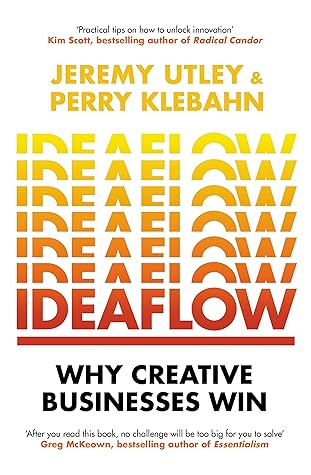More on this book
Kindle Notes & Highlights
creativity is the way your contribution goes from incremental to exponential.
As we’ve said, an idea is simply a new connection between two things that were already floating around in your head.
A problem, as we’ve said, is anything you don’t already know how to do.
Never pick when you can test.
Ideas are solutions to future problems. They represent tomorrow’s profits. No ideas, no tomorrow.
The most useful measure of creativity we’ve found is as follows: the number of novel ideas a person or group can generate around a given problem in a given amount of time. We call this metric ideaflow.
The sole substance of genius is the daily act of showing up.1 —MARIA POPOVA
“Be regular and orderly in your life,” Gustave Flaubert, author of Madame Bovary, advised a friend, “[so] that you may be violent and original in your work.”)
Performing an Idea Quota is a simple, three-S process: 1. Seed. Select a problem and study it. 2. Sleep. Let the unconscious mind process the problem. 3. Solve. Flood the problem with ideas.
Notably, Limb sees a parallel between the creative and dreaming states. “[When] you’re dreaming you’re also dealing with unplanned outcomes and free associations,” he said. “One of our most creative times is when we’re dreaming—we’re not inhibited and so we have the capacity to be incredibly imaginative.”
Simply walking through a doorway is enough to cue the brain to dump working memory.
How many ideas does it actually take to arrive at a great one? In our experience, the answer is something on the order of two thousand. Yes, that’s a two with three zeros after it—2,000 to 1. We call this the Idea Ratio.
When we suggest a ratio of 2,000 possibilities to 1 delivered solution, we’re counting every combination, variation, and refinement along the entire innovation pipeline.
We can divide these numbers in two and do a little rounding to make it easier to remember: To arrive at a single successful product, 2,000 ideas become 100 working prototypes. Those 100 prototypes become 5 commercial products. Of the final 5, 1 will succeed. To truly grasp the implications of 2,000:100:5:1, however, forget the fact that we’re talking about toys, or even products in general. What we’ve found working with innovators of every kind is that the scale of this approach applies universally.
We are trying to prove ourselves wrong as quickly as possible, because only in that way can we find progress.1 —RICHARD FEYNMAN
Under pressure, the mind relies more heavily on instinct. Then it justifies these intuitive decisions retroactively, adding a gloss of logic and reason to choices that were driven by cognitive biases.
Reality is an excellent source of creative input. Through experimentation, your ideas will benefit from the lessons of costs, clients, and customers.
“You can’t help but recognize traction,” Thorne told us. “Things that aren’t working are always ‘Maybe this is working, and maybe it’s not.’ Good ideas are abundantly clear. Everything becomes a lot easier. Exponentially easier.”
Progress wasn’t a matter of having good ideas but rather “building this system and this process and this culture for testing lots of bad ideas.”
“Half of the value we bring to the organization is in killing stuff,” Barreaud told us. “The more ideas you kill, the more resources you free up for other things that have a chance of going all the way. The stuff that will resonate with customers.”
“Most of the time, the problem is the problem.” If you’re not willing to reframe the problem to explore a more productive avenue, you’ll end up spinning your tires.
Psychologist Heidi Grant and leadership expert David Rock make the argument that “nonhomogeneous teams are simply smarter,” marshaling convincing evidence for the positive effect of ethnic, racial, and gender diversity on business outcomes.2 Diverse teams perform better and make fewer mistakes even as they innovate more effectively.
Thomas Schelling once wrote, “One thing a person cannot do, no matter how rigorous his analysis or heroic his imagination, is to draw up a list of things that would never occur to him!”
According to Dunbar’s research, collaboration spurs innovation because what’s hidden from us is often obvious to someone else.
When you talk to a user or customer with this tool, your goal is to understand their experience on an emotional level.
The gap between your assumptions and their reality is where you’ll find your insights.
what we’re reading enters our minds without much conscious awareness of the words themselves. Read the same word over and over, however, and its shape will become meaningless, the letters a row of squiggly abstractions. Psychologists call this phenomenon semantic satiation.
Imitation is how we learn. Originality isn’t about reinventing the wheel every time you go for a drive. Use the existing solution as a template and take it as far as it goes. When you arrive at the point where the existing solution disappoints or frustrates users, experiment from there. Innovation begins at the point of friction where things break down.
You don’t innovate in the pickle business by eating cucumbers all day. The more “distant” the origins of your inputs, the more valuable and interesting the resulting combinations will be.
The media theorist Marshall McLuhan made a distinction between “hot” and “cool” media. A hot medium like television is rich with information but creates a state of passive absorption. A cool one, like a book, is less overwhelming and requires more active involvement. As you might guess, a hot medium won’t give your mind the necessary space to work.


